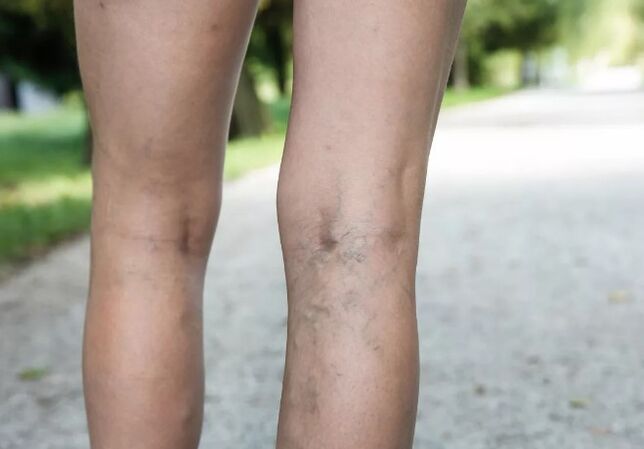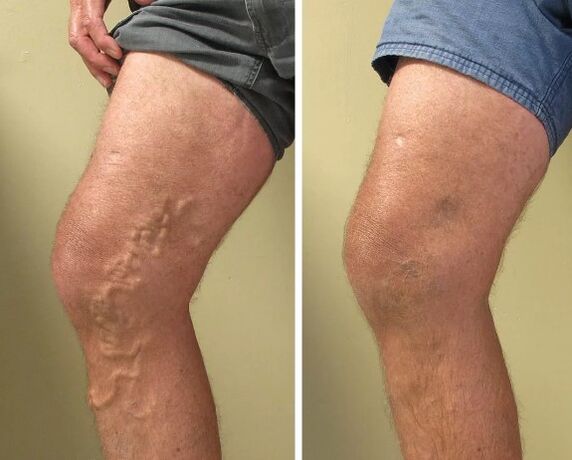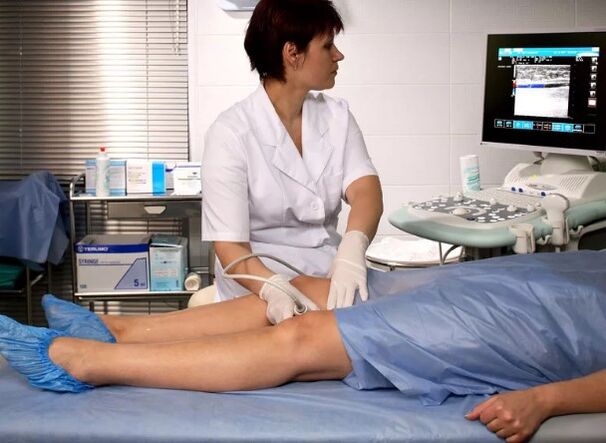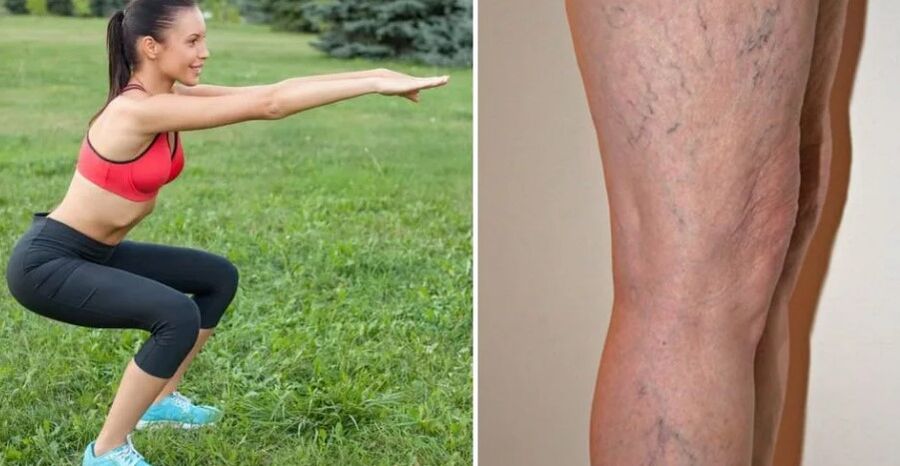A specific extension of the veins of the lower limbs, accompanied by a general violation of blood flow and valve failure. Expanding veins is typical of 40-60 year olds and men.
Development mechanism
The formation of such pathology as varicose veins can be considered as a violation of the normal functioning of venous valves as the occurrence of blood reflux (reflux reverse current). At the cellular level, this results in a violation of the balance between the components of the venous wall.
The initial stage is characterized by the presence of a genetic and causal factors (a longer period, overweight, injury and so on). At the same time, the so-called shear stress parameter changes, which is a set of blood movement detectors for blood vessels, to which the endothelium reacts very sensitively.
If the irritating factor affects the vascular wall for a long time, the leukocytes are firmly attached to the endothelial cells, which cause the initial stages of inflammation. The inflammatory process spreads on the venous channel of the lower limbs.
Especially quickly, such processes occur in valves that are subject to constant, heavy mechanical tension. However, inflammation on one foot can be pronounced better than in the other. Above all, this depends on the initial cause of the organ damage, for example, on the right foot, varicose veins can be pronounced better among athletes, who emphasize the emphasis.
Valves damage the blood of the blood through the mouth of a large and small subcutaneous veins. Due to the restart, the bloody flow, the wall of venous blood vessels occurs.
Over time, a dynamic venous hypertension develops, which is characterized by a decrease in pressure in the vessel, usually during walking, to the level of impossibility to ensure the perfusion of normal blood through the tissue.
Such a procedure is edema, the impregnation of subcutaneous tissue with blood cells (red blood cells and leukocytes). Over time, the skin changes its color, swelling, and skin pigmentation increases. With the death of cells, which is not harmless during medical care, which further leads to trophy ulcers.
Classification of varicoosa
From 2000, a new classification of the lower limbs has been developed.
Forms of Varicoosa:
- Intradermal or segmental varicose veins without pathological changes;
- Segmental varicose veins with superficial vein reflux;
- Surface veins are general varicos;
- Varicosis expansion in the presence of deep venous reflux.
The degree of chronic venous insufficiency:
- 0 - does not develop;
- I - "heavy legs" syndrome, appearance of edema;
- II - durable edema, eczema, lipodermosclerosis;
- III - Trophic ulcer.
Complications of the vein veins of the lower limb is one of the serious conditions that affects the body: thromboflebitis, trophy ulcers, erysipelians, erysipelians or bleeding.
The classification of the disease worker
By form:
- Varicosis of the subcutaneous vein of the thigh (from the mouth) - a decreasing varicose;
- increasing varicose veins (wen defeat, lower legs and legs, from bottom to top);
By clinical groups:
- The first group is the segmental internal extension of veins without perforators;
- The second group is the enlargement of venous fragments;
- The third group is the extension of the thigh's subcutaneous vein and the lower leg;
- The fourth group is the extension of a large and small subcutaneous vein with the presence of insolvent perforators;
- The fifth group is the expansion of surface veins, a large and small subcutaneous vein, with tissue induction.
Working classification by complications and chronic failure is no different from the standard.
The causes of the formation of varicoos
The exact cause of this pathology has not yet been clarified, but many factors contribute to the occurrence of varicos:
- genetic predisposition (the mutation gene responsible for the structure of the vascular wall is transmitted);
- Changes in hormonal background (pregnancy - during pregnancy in the body of hormones (the amount of progesterone increases and estrogen decreases), which directly affects the formation of blood coagulation factors);
- obesity (overweight leads to a sedentary lifestyle and consequently to break down);
- Diabetes mellitus (increased blood sugar levels over time damage the vascular wall over time);
- Alcohol consumption (a large amount of alcohol in the blood is the cause of drying and condensation of blood);
- heavy physical activity;
- congenital blood coagulation disorders;
- irrational nutrition, dietary errors;
- unpleasant and tight underwear (constant wear leads to compression of blood vessels);
- Frequent constipation (increased intraabdominal pressure in the lower limbs leads to heavy outflow of blood);
- permanent walk in the corner (development of stagnation and insufficient muscle movement);
- increased air temperature (leads to dehydration, condensation of blood and consequently the formation of blood clots);
- Cardiovascular disease and kidneys;
- overdose with drugs that increase blood coagulation;
- Surgical interventions (blood loss, vessel compression).

The sections of the varicoosa
During this period of the development of medicine, three main stages of varicose development and early stage are distinguished when the disease is very difficult to notice.
The early stage of the disease is swollen, weight, often patients are accompanied by the legs to hurt during a long walk. These are all signs of the onset of pathology, time to begin prevention - massage, foot creams, physical activity.
Expanding degree 1 degree veins.This stage is characterized by all the symptoms listed above, which are added to the vascular stars, the bruises of the legs, and the knotted veins visible through the skin. In addition, the appearance of cramps and combustion in the STOP area can be observed.
Expanding of degree 2 veins.At this stage, the number of stars and nodes increases and becomes more noticeable. The swelling appears, the pain in the legs increases and becomes unbearable.
Expanding degree 3 veins.This is the most difficult of the stage that is accompanied by serious injuries to the skin of the legs, dry, inanimate and cracked. The lower leg of the skin becomes dark blue, and its structure and pigmentation change.
The third stage is the last, when this pathological process can be called varicoosus. The subsequent development of processes becomes more serious illnesses.
We recommend that you consult a doctor in the second stage of the disease, as medical care is not provided with serious consequences over time.
The question immediately arises, "Which doctor will you go to? ", The answer is simply: a doctor specializing in the pathology of the veins of the lower limbs.
Symptoms and clinical varicos
The leading signs of this disease are a number of extensions of subcutaneous veins, which is why the disease is called. The beginning of the disease is usually accompanied by some and non -specific properties.
In this condition, the patients feel severity in the legs, rapid fatigue during movement, sometimes burning and cramps. In addition to the pain, the disease develops after a late afternoon edema, after a hard working day.
Long checks with veins are symptoms such as eczema and itching. Patients scratch their feet, causing uncomfortable feelings. Due to the development of the disease, the skin above the veins becomes thinner, and itchy places are constantly combed, leading to the appearance of wounds.
Over time, the skin color of the lower leg becomes bluish. If no medical care is provided in such a situation, the development of skin hyperpigmentation and lipodermasclerosis is possible. In even more advanced stages, tropical ulcers develop.
Diagnosis of the disease
Variable veins are visible and are not armed with an armed appearance, but how dangerous this condition should be using instrumental diagnostic methods.
Currently, the ultrasound methodology of duplex scanning of veins is the most informative method. It is used to evaluate the function of the valves, the cross -country ability and the presence of blood clots. Timely examination of veins avoids serious and irreversible consequences.
Treatment methods
How to treat varicoosis veins? Varicoos can only be cured with surgical intervention. People who have a hereditary willingness or risk factors recommend visiting a special physician 2-3 times a year, and the functioning of varicoses is prescribed in the second phase of the disease.
How much does the operation cost? The price can be done differently, depending on the severity of the disease.
Surgery
Flebe
Indications for veins' removal: extensive varicose veins, pathological expansion of subcutaneous veins, tropical ulcers, acute thromboflebitis, deep veins, and general malaise (fatigue, dizziness).
Contraindication of the disease: coronary heart disease, pregnancy, old age, severe infectious diseases, inflammatory processes.
The advantage of surgical treatment is that this is the only effective method of treatment in advanced forms of the disease.
The disadvantage of this treatment is trauma, anesthesia, post -operative period.
Laser therapy (EVVK)
Indications: Varicosis veins of the legs combined with various serious diseases (ischemia, thrombophlebitis, asthma, bronchitis, pleurisy, ulcer, cholecystitis, pyelonephritis, peritonitis, dermatitis and source).
Laser treatment is contraindicated in cases where it is noted: oncology, liver disease, kidneys, heart (stages of decompensation), pregnancy and cerebral sclerosis.
The advantage of such treatment is to get rid of the vascular pattern, the maximum fast procedure, the painless and safe, does not require stationary observation and atraumatic.
Disadvantages: Not available at all, expensive, the appearance of scars or clarification of the surrounding fabric is possible.
Radio -frequency coagulation of varicoos
Signals: Varico veins that are damaged by damage to a small and large subcutaneous vein with trunk trunk with trophy ulcers.
Contraindications: acute form of thromboflebitis, mental disorders, pregnancy.
Advantages: After surgery, painless, hospital care does not interfere with work.
Disadvantages: expensive procedure.
Sclerotherapy
Signs: Varicos veins in the early stages.
Contraindications: pregnancy, breastfeeding, allergic reaction to sclerizants, the inflammatory process of the legs, thrombosis.
The advantage of this treatment method is that such treatment is cheaper than surgery, quick healing, the best cosmetic effect.
Disadvantages: Entering the scleros into its deep veins may not be effective enough with the advanced forms of the disease.
Drug treatment
Medication treatment promotes the condition of blood vessels, valves, improves blood and lymphatic stream, and eliminates inflammation, but does not cure the patient.
How to handle?

All the necessary products from varicos are divided:
- Flebotonics;
- non -teroid analgesics;
- hormonal drugs;
- antitromboid;
- Aspirin -based drugs.
Home treatment
Traditional medicine provides the use of various ointments, creams, tinctures, legs or decoctions.
Apple vinegar treatment varicoosis veins. However, it is impossible to cure such a disease with folk recipes to alleviate the symptoms, especially in the early stages of development. For this, apple vinegar is used for packaging, deletion, oral administration or compression.
How to avoid the disease?
Sedient lifestyle, constant work, pregnancy is a greater load, which results in a disease such as varicos.
Varicosis in women has the same problem as cellulite, so special creams, creams, compression stockings and lymphatic drain have been developed to combat it.
According to statistics, men are extremely rare, and even if they develop much slower.
Can I play sports?
Varicosis and running are two factors that always come nearby. The most effective prevention of extending the veins of stages is constant physical effort: running, gymnastics, various power exercises, bicycles and so on.
There are many simple exercises to improve blood flow and prevent varicos:
- The foot rotation is 20 times in both directions clockwise.
- Work with your fingers. Extended 20 times and extend our fingers.
- Stars on the socks, then around the corner, and after the corner of the sock and the retreat 20-30 times.























